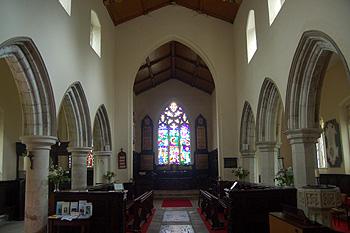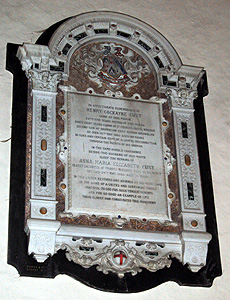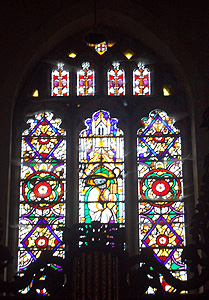Cockayne Hatley Church Repairs and Alterations
Most of the structural history of the church can be found in detail in Bedfordshire Historical Record Society Volume number 77 of 1998 Bedfordshire Churches in the Nineteenth Century: Part II: Parishes H to R put together by former County Archivist Chris Pickford from numerous sources some held by Bedfordshire Archives and some held elsewhere or published.

The interior looking east, Sept 2011
It was reported in 1602 that the chancel was decayed and the chancel door walled up. In 1669 the building was noted as "out of Repaire". However, churchwardens' accounts for 1778-1788 record regular maintenance by the parish.
The most interesting feature of the church is the continental woodwork introduced by the squire, the Hon. and Rev. Henry Cockayne Cust, after he restored the fabric in the early 19th century. Cust became squire and rector in 1806; the church was in a very poor state of repair and on Christmas Day 1806 snow fell through the roof and onto the altar during the service. The restoration of the chancel was complete by 1817 and further work took place afterwards including the renewal of the nave roof and the remodelling of the top of the tower. At this time the interior was relatively bare, there were a few modern pews and old oak benches. There were also fragments of old glass. By December 1827 the stalls and carved woodwork, the tower screen and west gallery, the pulpit and the lectern were all in place. Most of the woodwork is from Belgium. The tower screen is from Louvain; the rails above are from Malines. They display musical instruments and trophies. The stalls and stall backs are from Aulne Abbey near Charleroi and are dated 1689. The stalls have inlay and putto heads between them. The backs have Catholic saints in oval foliage surrounds. The communion rail also comes from Malines and has scenes of putti: corn harvest, vine harvest, drinking water and gathering Manna. The north aisle screen comes from St Bavon at Ghent and is a mixture of parts from c.1540 to the 17th century. Later additions included the ministers desk, the angels on the nave roof, the stained glass, the organ on the west gallery (in fact a dummy set of painted pipes) and the bells and bell frame.

Memorial to Henry Cockayne Cust, Sept 2011
In an article on the church in the Northampton Mercury of 26th June 1852 ‘W.A.’ (John Martin, who wrote a series of articles on Bedfordshire churches) wrote "Interesting and curious as the whole of the interior is, it may be questionable whether it is sufficiently simple for a rustic congregation" but that because of the small size of the local population it could almost be considered as a private chapel and "thus not within the ordinary rule of a parish church".
Further restoration work was needed by 1876 but not much was done until 1889-92. The work was partly funded through the sale of a Raffael-ware dish through Christies for £90 in 1889 and by subscriptions. The tower was repaired by Professor Richardson in 1928 and in 1930 the exterior was restored. The pulpit was sold to Carlisle cathedral in 1963 when further work became necessary to prevent the closure of the church.

The west window, Sept 2011
The stained glass in the east window of the north aisle comes from Yorkshire. It features four saints under canopies which are characteristic of the 14th century; in the head are 15th century figures. The east window is by Willement, 1829, and is entirely pictorial. The inspiration is early 16th century glass from the Netherlands. His south and north windows of 1839 are much more conventional.